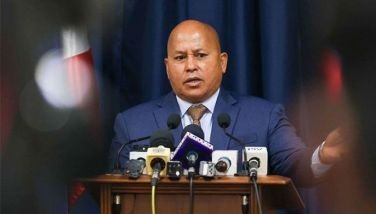RP expected to strengthen defense ties with US
March 18, 2005 | 12:00am
WASHINGTON — The Philippines is one of the United States’ allies that are seen to strengthen military alliance with the superpower as the US rethinks its military strategy to avoid long-drawn conflicts.
With the Pentagon facing planning contingencies across "an arc of instability" from the eastern Mediterranean to the Gulf to east Asia, the United States is more likely to need allies over the next 15 years than during the past 15, said Andrew Krepinevich, who heads a Washington think tank that specializes in military strategy.
"When you look at current deployments then what you see is US forces are really quite overstretched right now, especially the ground forces," said Krepinevich.
He sees the Pentagon revamping Cold War-era alliances and giving greater priority to security ties with countries in high-risk areas that have large pools of military manpower to draw from.
Australia, Japan, Singapore, possibly the Philippines, India, Turkey and Israel are among the countries whose importance may grow, he said. NATO, once supreme among US military alliances, is likely to be less relevant, he said.
"Increasingly the fight is not between countries, it is within countries," said one defense official, who spoke on condition of anonymity. "That calls for a different focus."
The emphasis on building partnerships anticipates a more proactive role for the military in helping strengthen the militaries in countries threatened by insurgencies, he said.
The Pentagon already has begun to build up special operations forces to work with militaries in Africa and other areas with large ungoverned areas that could be used as a haven for extremist groups.
Still battling insurgents two years after entering Iraq, the US military is being forced to rethink a strategy of winning quick wars with high tech forces that failed to anticipate such a long conflict.
US Defense Secretary Donald Rumsfeld this month gave the military four "core" problems to tackle as it undertakes a major review of military capabilities. At the top of his list was building "strategic partnerships" with other countries, defense officials said.
"We want to engage before there is some type of a conflict, and prevent conflicts from becoming wars," one official told AFP. "That is a different mindset in fighting and winning our nation’s wars."
It’s a shift born of necessity: so many US ground forces are tied down in Iraq that the US military would be hard pressed to come up with the troops to fight a second major ground war, as the current strategy calls for, analysts say.
Military leaders insist the United States can still respond quickly to contingencies in other parts of the world.
They emphasize that US air and naval power, not American ground forces, are the key elements of deterrence in flashpoints from Iran to North Korea and Taiwan.
The last major strategy review four years ago concluded that US forces should be capable of swiftly beating enemies in two major overlapping wars and removing the regime in at least one of them.
It also envisioned a force capable of seizing the initiative in 10 days, achieving limited military objectives in 30 days and being ready to move to another part of the world in another 30 days.
In Iraq, the US military put on a brilliant demonstration of that target, capturing Baghdad and toppling the regime of Saddam Hussein in less than a month.
But that proved the easiest part of a messy conflict that has now claimed more than 1,500 US lives. — AFP
With the Pentagon facing planning contingencies across "an arc of instability" from the eastern Mediterranean to the Gulf to east Asia, the United States is more likely to need allies over the next 15 years than during the past 15, said Andrew Krepinevich, who heads a Washington think tank that specializes in military strategy.
"When you look at current deployments then what you see is US forces are really quite overstretched right now, especially the ground forces," said Krepinevich.
He sees the Pentagon revamping Cold War-era alliances and giving greater priority to security ties with countries in high-risk areas that have large pools of military manpower to draw from.
Australia, Japan, Singapore, possibly the Philippines, India, Turkey and Israel are among the countries whose importance may grow, he said. NATO, once supreme among US military alliances, is likely to be less relevant, he said.
"Increasingly the fight is not between countries, it is within countries," said one defense official, who spoke on condition of anonymity. "That calls for a different focus."
The emphasis on building partnerships anticipates a more proactive role for the military in helping strengthen the militaries in countries threatened by insurgencies, he said.
The Pentagon already has begun to build up special operations forces to work with militaries in Africa and other areas with large ungoverned areas that could be used as a haven for extremist groups.
Still battling insurgents two years after entering Iraq, the US military is being forced to rethink a strategy of winning quick wars with high tech forces that failed to anticipate such a long conflict.
US Defense Secretary Donald Rumsfeld this month gave the military four "core" problems to tackle as it undertakes a major review of military capabilities. At the top of his list was building "strategic partnerships" with other countries, defense officials said.
"We want to engage before there is some type of a conflict, and prevent conflicts from becoming wars," one official told AFP. "That is a different mindset in fighting and winning our nation’s wars."
It’s a shift born of necessity: so many US ground forces are tied down in Iraq that the US military would be hard pressed to come up with the troops to fight a second major ground war, as the current strategy calls for, analysts say.
Military leaders insist the United States can still respond quickly to contingencies in other parts of the world.
They emphasize that US air and naval power, not American ground forces, are the key elements of deterrence in flashpoints from Iran to North Korea and Taiwan.
The last major strategy review four years ago concluded that US forces should be capable of swiftly beating enemies in two major overlapping wars and removing the regime in at least one of them.
It also envisioned a force capable of seizing the initiative in 10 days, achieving limited military objectives in 30 days and being ready to move to another part of the world in another 30 days.
In Iraq, the US military put on a brilliant demonstration of that target, capturing Baghdad and toppling the regime of Saddam Hussein in less than a month.
But that proved the easiest part of a messy conflict that has now claimed more than 1,500 US lives. — AFP
BrandSpace Articles
<
>
- Latest
- Trending
Trending
Latest
Trending
Latest
Recommended





























